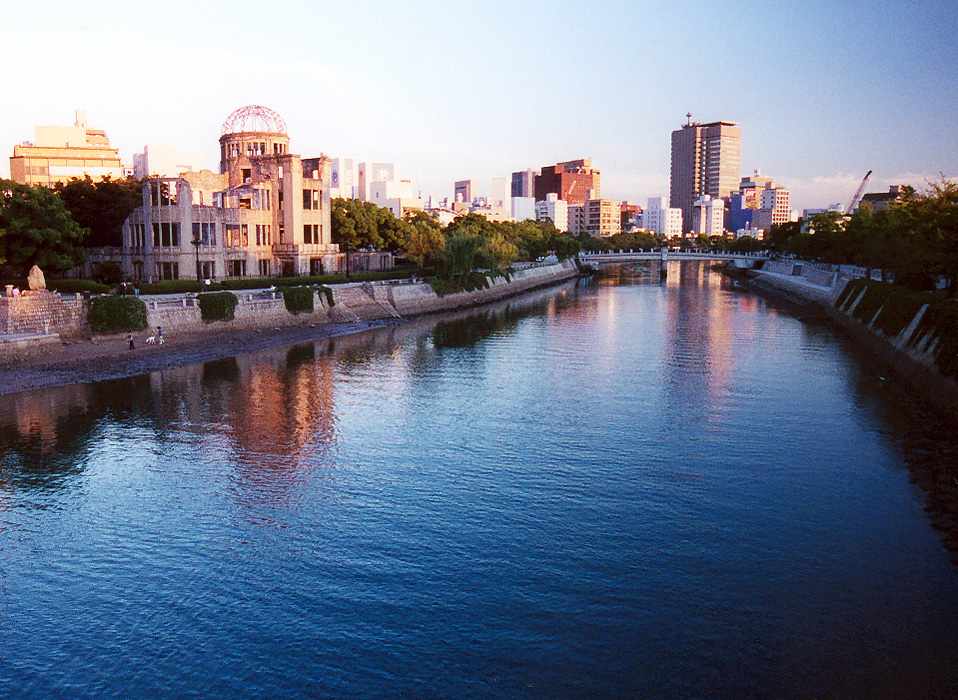
"Gembaku Domu" - The Atomic Bomb Dome
It will go down as one of the most inspiring survival stories ever to emerge from a horrific war. Tsutomu Yamaguchi was in his twenties when he found himself in Hiroshima on the morning of 6 August 1945, as a single B-29 US bomber droned overhead. The "Little Boy" bomb that it dropped from its payload would kill or injure 160,000 people by the day's end. Among them was the young engineer – who was in town on a business trip for Mitsubishi Heavy Industries – who stepped off a tram as the bomb exploded. Despite being 3km (just under two miles) from Ground Zero, the blast temporarily blinded him, destroyed his left eardrum and inflicted horrific burns over much of the top half of his body. The following morning, he braved another dose of radiation as he ventured into Hiroshima city centre, determined to catch a train home, away from the nightmare. But home for Mr Yamaguchi was Nagasaki, where two days later the "Fat Man" bomb was dropped, killing 70,000 people and creating a city where, in the words of its mayor, "not even the sound of insects could be heard". In a bitter twist of fate, Yamaguchi was again 3km from the centre of the second explosion. In fact, he was in the office explaining to his boss how he had almost been killed days before, when suddenly the same white light filled the room. "I thought the mushroom cloud had followed me from Hiroshima," Mr Yamaguchi said....
 WASHINGTON — Even a small nuclear exchange could ignite mega-firestorms and wreck the planet’s atmosphere.
New climatological simulations show 100 Hiroshima-sized nuclear bombs — relatively small warheads, compared to the arsenals military superpowers stow today — detonated by neighboring countries would destroy more than a quarter of the Earth’s ozone layer in about two years.
Regions closer to the poles would see even more precipitous drops in the protective gas, which absorbs harmful ultraviolet radiation from the sun. New York and Sydney, for example, would see declines rivaling the perpetual hole in the ozone layer above Antarctica. And it may take more than six years for the ozone layer to reach half of its former levels.
Researchers described the results during a panel Feb. 18 at the annual meeting of the American Association for the Advancement of Science, calling it “a real bummer” that such a localized nuclear war could bring the modern world to its knees.
“This is tremendously dangerous,” said environmental scientist Alan Robock of Rutgers University, one of the climate scientists presenting at the meeting. “The climate change would be unprecedented in human history, and you can imagine the world … would just shut down.”
To defuse the complexity involved in a nuclear climate catastrophe, Wired.com sat down with Michael Mills, an atmospheric chemist at the National Center for Atmospheric Research, who led some of the latest simulation efforts....
WASHINGTON — Even a small nuclear exchange could ignite mega-firestorms and wreck the planet’s atmosphere.
New climatological simulations show 100 Hiroshima-sized nuclear bombs — relatively small warheads, compared to the arsenals military superpowers stow today — detonated by neighboring countries would destroy more than a quarter of the Earth’s ozone layer in about two years.
Regions closer to the poles would see even more precipitous drops in the protective gas, which absorbs harmful ultraviolet radiation from the sun. New York and Sydney, for example, would see declines rivaling the perpetual hole in the ozone layer above Antarctica. And it may take more than six years for the ozone layer to reach half of its former levels.
Researchers described the results during a panel Feb. 18 at the annual meeting of the American Association for the Advancement of Science, calling it “a real bummer” that such a localized nuclear war could bring the modern world to its knees.
“This is tremendously dangerous,” said environmental scientist Alan Robock of Rutgers University, one of the climate scientists presenting at the meeting. “The climate change would be unprecedented in human history, and you can imagine the world … would just shut down.”
To defuse the complexity involved in a nuclear climate catastrophe, Wired.com sat down with Michael Mills, an atmospheric chemist at the National Center for Atmospheric Research, who led some of the latest simulation efforts....